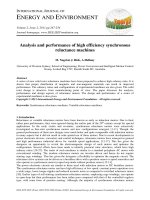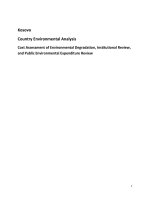analysis and deformulation of polymeric materials paints, plastics, adhesives, and inks
Bạn đang xem bản rút gọn của tài liệu. Xem và tải ngay bản đầy đủ của tài liệu tại đây (3.94 MB, 353 trang )
Analysis and Deformulation
of Polymeric Materials
Paints, Plastics, Adhesives, and Inks
TOPICS IN APPLIED CHEMISTRY
Series Editors: Alan R. Katritzky, FRS
Kenan Professor of Chemistry
University of Florida, Gainesville, Florida
Gebran J. Sabongi
Laboratory Manager, Encapsulation Technology Center
3M Company, St. Paul, Minnesota
Current volumes
in
the series:
ANALYSIS AND DEFORMULATION OF
POLYMERIC MATERIALS
Paints, Plastics, Adhesives, and Inks
Jan
W.
Gooch
CHEMISTRY AND APPLICATIONS OF LEUCO DYES
Edited by Ramaiah Muthyala
FROM CHEMICAL TOPOLOGY TO THREE-DIMENSIONAL
GEOMETRY
Edited by Alexandru
T.
Balaban
LEAD-BASED PAINT HANDBOOK
Jan
W.
Gooch
ORGANOFLUORINE CHEMISTRY
Principles and Commercial Applications
Edited by R.
E.
Banks,
B.
E. Smart, and J.
C.
Tatlow
PHOSPHATE FIBERS
Edward
J.
Griffith
POLY(ETHYLENE GLYCOL) CHEMISTRY
Biotechnical and Biomedical Applications
Edited by J. Milton Harris
RADIATION CURING
Science and Technology
Edited by
S.
Peter Pappas
RESORCINOL
Its Uses and Derivatives
Hans Dressler
TARGET SITES FOR HERBICIDE ACTION
Edited by Ralph
C.
Kirkwood
A
Continuation Order Plan is available for this series.
A
continuation order will bring delivery of each new
volume immediately
upon
publication. Volumes are billed only upon actual shipment. For further informa-
tion please contact the publisher.
Analysis and Deformulation
of Polymeric Materials
Paints,
Plastics,
Adhesives, and Inks
Jan W. Gooch
Polymers and Coatings Consultant
Atlanta. Georgia
KLUWER ACADEMIC PUBLISHERS
New York / Boston / Dordrecht / London / Moscow
eBook ISBN: 0-306 46908-1
Print ISBN: 0-306-45541-2
©2002 Kluwer Academic Publishers
New York, Boston, Dordrecht, London, Moscow
Print ©1997 Kluwer Academic / Plenum Publishers
New York
All rights reserved
No part of this eBook may be reproduced or transmitted in any form or by any means, electronic,
mechanical, recording, or otherwise, without written consent from the Publisher
Created in the United States of America
Visit Kluwer Online at:
and Kluwer's eBookstore at:
Preface
This book is designed for the chemist, formulator, student, teacher, forensic
scientist, or others who wish to investigate the composition of polymeric materials.
The information withinthese pages is intendedto
arm
the reader with the necessary
working knowledge to analyze, characterize, and deformulate materials.
The structure of theContents is intended to assistthereaderin quickly locating
the subject of interest and proceed to it with a minimum of expended time and effort.
The Contents provides an outline of major topics and relevant materials charac
-
terized for the reader’s convenience. An introductionto analysis and deformulation
is provided in Chapter
1
to acquaint the reader with analytical methods and their
applications. Extensive references are provided as additional sources of informa
-
tion. All tables are located in the Appendix, beginning on p.
235.
GUIDE FOR USE
This is a practical book structured to efficiently use the reader’s time with a
minimum effort of searching for entries and information by following these brief
instructions:
1.
Search the Contents and/or Index for a subject within the text.
2.
Analysis/deformulation principles are discussed at the outset to familiarize
the reader with analysis methods and instruments; followed by formula
-
tions, materials, and analysis of paint, plastics, adhesives, and inks; and
finally reformulation methods to test the results of analysis.
3.
Materials and a wide assortment of formulations are discussed within the
text by chapter/section number.
4.
Materials are referred to by various names (trivial, trade, and scientific),
and these are listed in tables and cross
-
referenced to aid the reader.
v
vi Preface
ACKNOWLEDGMENTS
I wish to thank the following people for their contributions to this book: Lisa
Detter
-
Hoskin; Garth Freeman; John Sparrow; Joseph Schork; Gary Poehlein, Kash
Mittal; John Muzzy; Paul Hawley; Ad Hofland; Tor Aasrum; James Johnson; Linda,
Sonja, Luther, and Lottie Gooch.
Contents
List of Figures
xvii
1
.
Deformulation Principles
1.1.
Introduction
1.2. Characterization
of
Materials
2
1.3. Formulation and Deformulation
2
1
2
.
Surface Analysis
2.1. Light Microscopy(LM)
7
2.1.1. Fundamentals
7
2.1.2. Equipment
12
2.1.3. Applications
12
2.2.1. Fundamentals
13
2.2.2. Equipment
17
2.2.3. Applications
18
2.3. Energy
-
DispersiveX
-
Ray Analysis (EDXRA)
19
2.3.1. Fundamentals
19
2.3.2. Equipment
21
2.3.3,
Applications
21
2.4. Electron Probe Microanalysis(EPM)
21
2.4.1. Fundamentals
21
2.4.2. Equipment
2.4.3. Applications
22
2.5. Auger Spectroscopy (AES)
2.5.1. Fundamentals
24
2.5.2. Equipment
25
2.2. Electron Microscopy (EM)
13
22
24
vii
viii Contents
2.5.3. Applications
25
2.6. Scanning Ion Mass Spectroscopy (SIMS)
27
2.6.1. Fundamentals
27
2.6.2. Equipment
27
2.6.3. Applications
29
2.7. Electron Spectroscopy Chemical Analysis (ESCA)
29
2.7.1. Fundamentals
29
2.7.2. Equipment
31
2.7.3. Applications
31
.
2.8. Infrared Spectroscopy(IR) for SurfaceAnalysis
31
2.8.1. Fundamentals
31
2.8.2. Equipment
40
2.8.3. Applications
40
2.9. Surface Energy and Contact Angle Measurement
42
2.9.1. Fundamentals
42
2.9.2.
Equipment
44
2.9.3. Applications
44
3
.
Bulk
Analysis
3.1. Atomic Spectroscopy(AS)
45
3.1.1. Fundamentals
45
3.1.2. Equipment
49
3.1.3. Applications
49
3.2. Infrared Spectroscopy
(IR)
for Bulk Analysis
49
3.2.1. Fundamentals
49
3.2.2. Equipment
51
3.3. X
-
Ray Diffraction (XRD)
3.3.1. Fundamentals
58
3.3.2. Equipment
63
3.3.3. Applications
63
Gas Chromatography(GC)
65
3.4.1. Fundamentals
65
3.4.2. Equipment
66
3.4.3. Applications
66
3.5.1. Fundamentals
70
3.5.2. Equipment
77
3.6. Thermal Analysis
77
58
3.4. Gel Permeation (GPC), High
-
pressure Liquid (HPLC), and
3.5. Nuclear Magnetic Resonance Spectroscopy (NMR)
70
3.5.3. Applications
77
Contents
ix
3.6.1. Fundamentals
77
3.6.2. Equipment
77
3.6.3. Applications
79
3.7. Viscometric Analysis
85
3.7.1. Fundamentals
85
3.7.2. Equipment
88
3.7.3. Applications
88
3.8. X
-
Ray Microscopy
89
3.8.1. Fundamentals
89
3.8.2. Equipment
90
3.8.3. Applications
91
3.9. Mass Spectroscopy
92
3.9.1. Fundamentals
92
3.9.2. Equipment
92
3.9.3. Applications
92
3.10. Ultraviolet Spectroscopy
92
3.10.1. Fundamentals
92
3.10.2. Equipment
96
3.10.3. Applications
96
4.
Paint
Formulations
4.1. General
97
4.1.1. The Paint Formula
4.1.2. Functions
of
Paint and Coatings
4.1.3. Classification
98
4.2. Solvent Systems
101
4.3. Waterborne Systems
101
4.4. Powder Systems
101
4.5. Electrodeposition Systems
101
4.5.1. Anionic Electrodeposition Coatings
4.5.2. Cationic Electrodeposition Coatings
103
4.6. Thermal Spray Powder Coatings
4.7. Plasma Spray Coatings
105
4.7.1. Principles
of
Operation
105
4.7.2. Plasma Sprayable Thermoplastic Polymers
4.7.3. Advantages
of
Plasma Sprayed Coatings
4.8. Fluidized Bed Coatings
106
4.9. Vapor Deposition Coatings
106
4.10.
Plasma Polymerized Coatings
106
97
98
102
106
104
106
x Contents
5.
Paint
Materials
5.1. Oils
109
5.1.1. Composition
109
5.1.2. Properties
109
5.1.3. Oil Treatments
110
5.1.4. Linseed Oil
110
5.1.5. Soybean Oil
110
5.1.6. Tung Oil (China
-
Wood Oil)
110
5.1.7. Oiticica Oil
111
5.1.8. Fish Oil
111
5.1.9. Dehydrated Castor Oil
111
5.1.10. Safflower Oil
111
5.1.11. Tall Oils
111
5.2. Resins
112
5.2.1. General
112
5.2.2. Rosin
112
5.2.3. Ester Gum
112
5.2.4. Pentaresin
112
5.2.5. Coumarone
-
Indene (Cumar) Resins
113
5.2.6. Pure Phenolic Resins
113
5.2.7. Modified Phenolic Resins
113
5.2.8. Maleic Resins
113
5.2.9. Alkyd Resins
114
5.2.10. Urea Resins
114
5.2.11. Melamine Resins
114
5.2.12. Vinyl Resins
5.2.13, Petroleum Resins
115
115
5.2.14. Epoxy Resins
115
5.2.15. Polyester Resins
115
5.2.16. Polystyrene Resins
115
5.2.17. Acrylic Resins
116
5.2.18. SiliconeResins
116
5.2.19. Rubber
-
Based Resins
116
5.2.20. Chlorinated Resins
116
5.2.21. Urethanes
117
5.3. Lacquers
117
5.4. Plasticizers
118
5.5. Water
-
Based Polymers and Emulsions
119
5.5.1. Styrene
-
Butadiene
119
5.5.2. Polyvinyl Acetate
119
5.5.3. Acrylics
119
xi
Contents
5.5.4. Other Polymers and Emulsions
120
5.6.
Driers 121
5.6.1.
Cobalt
121
5.6.2. Lead 121
122
5.6.3. Manganese
5.6.4. Calcium
122
5.6.5. Zirconium
122
5.6.6. Other Metals
122
5.7.2. AntisettlingAgents
123
5.7.3. AntiskinningAgents
123
Bodying and Puffing Agents
123
5.7.5. Antifloating Agents
123
Loss
of
Dry Inhibitors
123
5.7.7. Leveling Agents
124
5.7.8. Foaming
124
Grinding
of
Pigments
124
5.7.10. Preservatives
124
5.7.11
.
Mildewcides
124
5.7.12. Antisagging Agents
124
5.7.13. GlossingAgents
124
5.7.14. Flatting Agents
124
5.7.15. Penetration
125
5.7.16. Wetting Agents for Water
-
Based Paint
125
5.7.17. Freeze
-
Thaw Stabilizers
125
5.7.18. CoalescingAgents
125
5.8.1. Petroleum Solvents
126
5.8.2.
Aromatic Solvents
127
5.8.3. Alcohols, Esters, and Ketones
127
White Hiding Pigments
129
5.9.3. Black Pigments
131
5.9.4. Red Pigments
131
5.9.5. Violet Pigments
133
5.9.6. Blue Pigments
133
5.9.7. Yellow Pigments
134
5.9.8. Orange Pigments
135
5.9.9. Green Pigments
135
122
5.7.1. General
122
5.7. Paint Additives
5.7.4.
5.7.6.
5.7.9.
5.8. Solvents
125
128
5.9. Pigments
5.9.1. General
128
5.9.2.
xii Contents
5.9.10. Brown Pigments
136
5.9.11
.
Metallic Pigments
136
5.9.12. Special
-
Purpose Pigments
137
6.
Deformulation of Paint
6.1. Introduction
139
6.2. Deformulation of Solid Paint Specimens
139
6.3. Deformulationof Liquid Paint Specimens
144
6.3.1. Measurements and Preparation
of
Liquid Paint Specimen
144
6.3.2. Separated Liquid Fraction
of
Specimen
145
6.3.3. Separated Solid Fraction of Specimen
146
6.4.
Reformulation
148
7
.
Plastics Formulations
7.1. General 149
7.2. Thermoplastics
150
7.2.1. Homopolymers
150
7.2.2. Copolymers
150
7.2.3. Alloys
150
7.3. Thermosets
150
7.4. Fibers
1
50
7.5. Films 151
7.6. Foams
151
7.7. Gels
151
7.8. Elastomers, Rubbers, and Sealants
151
8.
Plastics Materials
8.1. General 153
8.1.1. Carbon Polymers
153
8.1.2. Amino Resins
153
8.1.3. Polyacetals
154
8.1.4. Polyacrylics
154
8.1.5. Polyallyls
155
8.1.6. Polyamides
155
8.1.7. Polydienes
156
8.1.8. Miscellaneous Polyhydrocarbons
156
8.1.9. Polyesters
157
8.1.10. Polyethers
158
Contents xiii
8.1.11. Polyhydrazines
159
8.1.13. Polyimides
159
8.1.14. Polyimines
160
8.1.15. Polyolefins
160
8.1.16. Polysulfides
160
8.1.17. Polysulfones
161
8.1.18. Polyureas
161
8.1.19. Polyazoles
161
8.1.20. Polyurethanes
161
8.1.2
1
.
Polyvinyls
162
8.1.22. Phenolic Resins
164
8.1.23. Cellulose and Cellulosics
164
8.1.24. Hetero Chain Polymers
164
8.1.25. Natural Polymers
165
8.2. Monomers and Related Materials
165
8.3. Additives for Plastics
166
8.3.1. Polymerization Materials
166
8.3.2. Protective Materials
167
8.3.3. Processing Materials
169
8.4. Standardsfor Propertiesof Plastic Materials
171
8.1.12.
Polyhalogenohydrocarbons
and Fluoroplastics
159
9
.
Deformulation of Plastics
9.1. Solid Specimens
173
9.2. Liquid Specimens
179
9.3. Nondestructive Examination of Plastic Parts
182
9.4.
Reformulation
182
10
.
Adhesives Formulations
10.1. General
183
10.1.1. Applications
183
10.1.2. Origin
184
10.1.3. Solubility
184
10.1.4. Method
of
Cure or Cross
-
Linking
10.2. Formulations
of
Adhesives by Use
184
185
11
.
Adhesives Materials
11.1. Introduction
187
xiv Contents
11.2. Synthetic Resins
187
11.2.1. Polyvinyl Acetal
187
11.2.2. Polyvinyl Acetate
187
1
1.2.3. Polyvinyl Alcohol
188
11.2.4. Polyvinyl Butyral
188
11.2.5. Polyisobutylene and Butyl
188
1
1.2.6. Acrylics
188
11.2.7. Anaerobics
189
11.2.8. Cyanoacrylates
189
11.2.9.
EthylvinylAlcohol (EVA)
190
11.2.10. Polyolefins
190
11.2.11. Polyethylene Terephthalate
190
11.2.12. Nylons
190
11.2.13. Phenolic Resins
191
11.2.14. Amino Resins
191
11.2.15. Epoxies
191
11.2.16. Polyurethane
191
11.3. Synthetic Rubbers
192
11.3.1. Styrene
-
Butadiene Rubber (SBR)
192
11.3.2. Nitrile Rubber
192
11.3.3. Neoprene
192
11.3.4. Butyl Rubber
192
1
1.3.5. Polysulfide
193
11.3.6. Silicone
193
11.3.7. Reclaimed Rubber
193
11.4. Low
-
Molecular
-
Weight Resins
193
11.5. Natural Derived Polymers and Resins
193
1
1.5.1. Animal Glues
194
11.5.2. Casein
195
11.5.3. Polyamide and Polyester Resins
195
11.5.4. Natural Rubber
195
11.6. Inorganic
195
11.7. Solvents, Plasticizers, Humectants, andWaxes
196
11.8. Fillers and Solid Additives
196
11.9. Curing Agents
196
12
.
Deformulation of Adhesives
12.1. Introduction
197
12.2. Solid Specimen
of
Adhesive
197
12.2.1. Surface Analysis
197
xv
Contents
12.2.2. Bulk Analysis
201
12.3. Liquid Specimen of Adhesive
201
12.4. Thermal Analysis of Solid Specimen
202
12.5. Reformulating from Data
203
13
.
Ink Formulations
13.1. General
205
13.2. Letterpress 207
13.3. Lithographic
208
13.3.1. Web Offset Inks
208
13.3.2. Sheet Offset Inks
209
13.3.3. Metal Decorating Inks
209
13.4. Flexographic
209
13.6.1. Screen Printing
210
13.6.2. Electrostatic
211
13.6.3. Metallic
211
13.6.4. Watercolor
211
13.6.5. Cold
-
Set
211
13.6.6. Magnetic
211
13.6.7. Optical
or
Readable
212
13.7. Ink Formulations
212
13.5. Gravure 210
13.6. Other Inks
210
13.8. Varnishes 212
14
.
Ink Materials
14.1. General 213
14.2. Vehicles 213
14.2.1. Nondrying Oil Vehicle
213
14.2.2. Drying Oil Vehicle
213
14.2.3. Others
214
14.4. Inorganic Pigments
215
14.4.1. Black Pigments
215
14.4.2. White Pigments
215
14.4.3. Chrome Yellow
215
14.4.4. Chrome Green
216
14.4.5. Chrome Orange
216
14.4.6. Cadmium(Selenide)Yellows
216
14.3. Solvents
214
xvi Contents
14.4.7. Cadmium
-
Mercury Reds
216
14.4.8. Vermilion
216
14.4.9. Iron Blue
216
14.4.10. Ultramarine Blue
216
14.5. Metallic pigments
216
14.5.1.
Silver
216
14.5.2. Gold
216
14.6. Organic Pigments
217
14.6.1. Yellows
217
14.6.2. Oranges
217
14.6.3. Reds
217
14.6.4. Blues
217
14.6.5. Greens
217
14.6.6. Fluorescents
217
14.7. Flushed Pigments
218
14.8. Dyes
218
14.9. Additives
218
14.9.1. Driers
218
14.9.2. Waxes and Compounds
218
14.9.3. Lubricants and Greases
218
Reducing Oils and Solvents
219
Body Gum and Binding Varnish
219
14.9.6. Antioxidants or Antiskimming Agents
219
14.9.7.
Corn
Starch
219
14.9.8. Surface
-
Active Agents
219
14.9.4.
14.9.5.
15
.
Deformulation of
Inks
15.1. Introduction
221
15.2. Deformulation of Solid Ink Specimen
221
15.3. Deformulation
of
Liquid Paint Specimen
225
15.4. Reformulation
228
References
229
Appendix
235
Index
329
List of Figures
CHAPTER 1
Figure
1.1.
Basic deformulation scheme for paint, plastics, adhesives, and inks.
Figure
1.2.
Separation of dispersed components from formulations.
Figure
1.3.
Photograph ofFisher Marathon Model
21K/R
General
-
Purpose Re
-
frigerated Centrifuge, maximum speed
13,300
rpm, temperature
range –20 to –40°C (A) Centrifuge; (B) eight place fixed angle ro
-
tor; and (C) Nalgene polypropylene copolymer centrifuge tubes
with screw caps.
CHAPTER 2
Figure
2.1.
Figure
2.2.
Figure
2.3.
Figure
2.4.
Figure
2.5.
Figure
2.6.
Figure
2.7.
Figure
2.8.
Figure
2.9.
Figure
2.10.
AES spectrum of alumina,
A1
2
O
3
.
Figure
2.11.
Photograph
of
Perkin
-
Elmer Scanning Ion Mass Spectrometer.
Figure
2.12.
TOF
-
SIMS spectrogram of polypropylene specimen.
Figure
2.13.
Photograph of Surface Science Laboratories, Model
SSX
-
100
Small
Figure
2.14.
ESCA spectrogram of paint pigment, lead carbonate, and calcium
Photograph of Leica Strate Lab Monocular Microscope.
Photograph
of
Leica
SZ6
Series Stereoscope.
Photomicrograph of paint specimen.
Photograph
of
Hitachi S
-
4500 Scanning Electron Microscope.
SEM micrograph of multilayered lead paint chip.
EDXRA spectrogram of talc mica particle shown in SEM micrograph
of Fig.
2.5.
Photograph of Acton MS64EBP Electron Beam Microanalyzer.
Electron beam microanalyzer spectrogram of chemically deposited
nickel and copper on high
-
purity aluminum foil.
Photograph of Perkin
-
Elmer Auger Electron Spectrometer.
Spot Electron Spectroscopy Chemical Analysis Spectrometer.
sulfate.
xvii
xviii List of Figures
Figure 2.15. Photograph
of
Perkin–Elmer FT
-
IR System 2000, microscopic
Figure 2.16. Perkin
-
Elmer FT
-
IR Microscope.
Figure 2.17. Infrared spectrum of toluene.
Figure 2.18.
1
H
-
NMR spectrum
of
toluene.
Figure 2.19. Measurement
of
contact angle of a solidmaterial using a goniometer.
Figure 2.20. Photograph of Ramé–Hart NRL ContactAngle Goniometer.
Figure 2.21. Surface energy determination
of
polytetrafluoroethylene (Teflon).
CHAPTER
3
Figure 3.1. Photograph of Perkin–Elmer 3
100
Atomic Absorption Spectrometer.
Figure 3.2. Photograph of Perkin
-
Elmer Plasma 400 ICI Emission Spectrometer.
Figure 3.3. X
-
ray data card for sodiumchloride.
Figure 3.4. Photograph
of
Rigaku X
-
Ray Diffractometer.
Figure 3.5. X
-
ray diffraction spectrum
of
lead pigment specimen.
Figure 3.6. Photograph of Perkin–Elmer Gel Permeation Chromatograph.
Figure 3.7. Photograph
of
Perkin–Elmer Integral 4000 High Performance Liquid
Chromatograph.
Figure 3.8. Photograph
of
Perkin
-
Elmer Autosystem XL Gas Chromatograph.
Figure 3.9. HypotheticalGPC chromatogram
of
a typical polymer.
Figure 3.10. HPLC chromatogram of anthracene.
Figure 3.11. GC chromatogram
of
three separate injections of diesel oil.
Figure 3.12.
1
H
-
NMR spectrum of p-tert-butyltoluene, proton counting.
Figure 3.13. Photograph of Bruker MSL
1
H/
13
C-NMR spectrometers, tabletop
Figure 3.14. Photograph
of
Perkin–Elmer DSC 7 Differential Scanning Calorime
-
Figure 3.15. Photograph of Perkin
-
Elmer TGA 7 Thermogravimetric Analyzer.
Figure 3.16. Photograph
of
Perkin–Elmer DMA 7 Dynamic Mechanical Analyzer.
Figure 3.17. Photograph of Perkin
-
Elmer TMA 7 Thermomechanical Analyzer.
Figure 3.18. Photograph
of
Perkin
-
Elmer DTA 7 Differential Thermal Analyzer.
Figure 3.19. Photograph of Perkin–Elmer computer and thermal analysis software
Figure 3.20. DSC thermogram
of
polypropylene.
Figure 3.21. TGA thermogram of polystyrene.
Figure 3.22. TMA thermogram of poly (styrene
-
co
-
butadiene) copolymer film.
Figure 3.23. DMA thermograms
of
poly (styrene
-
co
-
butadiene) copolymer films
of
different compositions.
Figure 3.24.
DTA thermograms of common polymers.
Figure 3.25. Photograph of Haake VT550 Viscometer.
Figure 3.26. Rheology curves
of
liquids
and
dispersions.
Cassegrain optical assemblies.
configuration.
ter.
program.
List of Figures
xix
Figure 3.27. X
-
ray micrograph of solder joint with internal defects, voids (light
areas), and broken leads.
Figure 3.28. Photograph of FEIN FOCUS Microfocus FXS
-
160.30 X
-
Ray Inspec
-
tion and Testing System.
Figure 3.29. Mass spectrometer spectrum
of
toluene.
Figure 3.30. Photograph of Bruker REFLEX MALD TOF
-
Mass Spectrometer.
Figure 3.31. Photograph of Cary 1EUV
-
Vis
-
NIR Spectrophotometer.
Figure 3.32. UV spectrum of pyridine.
CHAPTER
6
Figure 6.1.
Figure 6.2.
Figure 6.3.
Figure 6.4.
Figure
6.5.
Figure 6.6.
Figure
6.7.
Sources of paint and preparation of solid paint specimens for defor
-
mulation.
Scheme for deformulation of
a
solid paint specimen.
SEM micrograph (cross section) of a paint chip.
Solvent refluxing apparatus for separating vehicle from pigments in
paint chips.
Scheme for preparation of liquid paint specimen for deformulation.
Scheme for deformulation of liquid paint specimen.
Distillation apparatus for separation of solvents from liquid paint
specimens.
CHAPTER
9
Figure 9.1. Scheme for preparation
of
solid plastic specimen.
Figure 9.2. Scheme for deformulation
of
solid plastic specimen.
Figure 9.3. SEM micrograph of laminated plastic film.
Figure 9.4. EDXRA spectrogram of left side of laminated film.
Figure 9.5. EDXRA spectrogram of right side of laminated film.
Figure 9.6. IR spectrum of left side of laminated film.
Figure 9.7. IR spectrum of right side of laminated film.
Figure 9.8.
DSC
thermogram
of
laminated film.
Figure 9.9. Scheme for preparation of liquid plastic specimen for deformulation.
Figure 9.10. Scheme for deformulation of liquid plastic specimen.
Figure 9.11. X
-
ray micrograph
of
a
disposable lighter. Dark areas are metal and
light areas are plastic.
CHAPTER
12
Figure 12.1. Scheme for preparation of solid adhesive specimen for deformulation.
Figure 12.2. Scheme for deformulation of solid adhesive specimen.
xx
List of Figures
Figure 12.3. SEM micrograph
(
1000×) of aluminum aircraft panel bonded with
Figure 12.4. Scheme for preparation of liquid adhesive specimen for deformula
-
Figure 12.5. Scheme for deformulation of liquid adhesive specimen.
CHAPTER
15
Figure 15.1. Scheme for preparation of solid ink specimen for deformulation.
Figure 15.2. Scheme for deformulation of a solid ink specimen.
Figure 15.3. SEM micrographsof washable black writing pen ink.
Figure 15.4. Schemefor preparation
of
liquid ink specimen.
Figure 15.5. Scheme for deformulation of liquid ink specimen.
polysulfide two
-
part elastomeric sealant.
tion.
1
Deformulation Principles
1.1.
INTRODUCTION
You have a manufactured product or an unknown formulated material, and you
want to know its composition. How do you go about it without spending an
enormous amount of time and money? This book is designed to answer those
questions in great detail.
Just identifying a solid or liquid substance can be a challenging experience,
and accurately analyzing a multicomponent formulation can be an exhausting one.
In liquid or solid forms, a paint can resemble an adhesive, ink, or plastic material.
Therefore, we will explore extensively how to distinguish types of formulations
and how to efficiently, economically, and, hopefully, painlessly deformulate it.
Formulations can be mixtures of materials of widely varying concentrations
and forms. To investigate any formulated plastic, paint, adhesive, or ink material,
the investigator must have a plan to deformulate or reverse engineer, then analyze
each separated component. A typical formulation requires very specific isolation
of a mixture of chemical compounds before an identification of individual compo
-
nents can be attempted. The state and chemical nature of materials vary widely, and
require a host of analytical tools. Historically, the strategy for analysis has varied
as widely. Strategy is provided for using proven methods to untangle and charac
-
terize multicomponents from a single formulation.
The structure of this book as outlined in the Contents consists of a logical
scheme to allow the reader to identify a particular area of interest. The basic scheme
consists of formulations, materials used in the formulation, and followed by
methods of deformulation.
The reader is referred to texts on qualitative and quantitative chemistry
principles and techniques for precise laboratory methods.
There is a “deformulation” chapter following each paint, plastics, adhesives,
and inks materials chapter. Many of the deformulation principles are similar. For
this reason, the information is usually discussed once and referred to in other
deformulation chapters to eliminate repetition of the material.
1
2
Chapter
1
Standard materials found in formulations are well characterized, and the
results are presented in each case. The reader will find these characterizations
invaluable when comparing experimental results for purposes of identification.
1.2.
CHARACTERIZATION OF MATERIALS
Though materials come in different forms such as solids and liquids, methods
for accurate analysis are available. Successful analysis depends on isolation of
individual components and a proper selection of tools for investigation.
The typical properties of materials and methods of analysis are listed in Table
1.1 (see Appendix, p. 235). Types ofanalysis are discussedinChapters 2 (surface
analysis) and 3 (bulk analysis) together with corresponding analytical instruments.
No investigation can be performed without the proper tools, and materials such as
polymers and pigments require corresponding instrumentation for identification
and characterization such as infrared spectroscopy and X
-
ray diffraction. The
methods and equipment for surface and bulk analysis are discussed in Chapters 2
and 3. The emphasis is on information that is valuable to the user without going
into great detail about theory or hardware. The user will need to identify a competent
operator of equipment (or laboratory) to acquire the necessary analytical data.
It is seldom necessary to use all of the tools in Table 1.1 to identify components
in a formulation, but analysis by more than one method is recommended for
confirmation. In other words, what degree of confidence is required?
A standard or control specimen of a material is always recommended for
comparison to the specimen under study.
1.3. FORMULATION AND DEFORMULATION
A paint, plastic, adhesive, or ink is actually a mixture of materials to create a
formulation. Almost all formulations are types of dispersions including emulsions
and suspensions, and separation of the phases is the first step of deformulation. The
formulation is the useful form of materials to perform a task which is often a
commercial product. Physical measurements can be performed on a formulation
such as weight per gallon. However, the formulation must be treated as a mixture
and subdivided into its individual components. Only then can analysis of each
material begin. The general scheme for analysis
of formulations is illustrated in Fig.
1.1 showing methods
of identifying each component.
The first concern relates to whether the formulated materials are in solid or
liquid form. If the specimen is a liquid, then solids are separated using gravity
or
increased gravity called centrifugation. Separation of solids from fluids is described
by Stokes’s law (Weast,
1978):
When a small sphere (or particle) falls under the
action of gravity through a viscous medium, it ultimately acquires a constant
velocity V (cm/sec),
Deformulation Principles
3
Figure
1.1.
Basic deformulation scheme for paint, plastics, adhesives, and inks.
V= [2ga
2
(d
1
-
d
2
)]/9η
where a (cm) is the radius of the sphere,
d
1
and d
2
(g/cm
3
) the densities of the sphere
and the medium, respectively, η (dyn-sec/cm
2
, or poise) the viscosity, and g
(cm/sec
2
) the gravity.
From Stokes’s law, the greater the differences in density of the particle and the
medium, the greater is the rate of separation. Also, the closer the particle resembles
a perfect sphere, the greater is the rate of sedimentation and separation.
A liquid
formulation is subjected to several orders of gravity by spinning in a mechanical
centrifuge. Earth’s gravity causes particles to naturally fall through fluids such as
water and air, but mechanical centrifugation greatly accelerates the motion of the
particle. Mechanical centrifugation can reduce the time for separation to a couple
4 Chapter1
of hours compared to years at natural gravity conditions. Centrifugal force is
defined as
F=(mv
2
)/R
where F (dyn) is force, m (g) is mass, v (cm/sec) is velocity, and R (cm) is radius
of rotation. From this equation, increasing velocity dramatically increases force by
the square of the velocity. Many dispersions never separate under natural gravity,
or filtration.
A
liquid specimen is centrifuged or filtered to separate major components such
as resin/solvent fraction and pigments which can be further separated.
A
laboratory
centrifugation separation is illustrated in Fig. 1.2. A photograph of a Fisher
Marathon centrifuge is shown in Fig. 1.3. Centrifugation
of
components is an
efficient method of separating emulsions and suspensions as all of the components
separate in individual layers by density. Decreasing the temperature of a liquid
suspension can sometimes aid the separation, and can reduce the vapor pressure of
a volatile solvent like acetone. Temperature control is important because heat is
generated during centrifugation. A centrifuge with temperature control is shown in
Fig. 1.3 with a fixed angle rotor and centrifuge tube. No filtering is required when
using centrifugation, However, dissolved resins and polymers in solvents do not
Centrifuge Tube/Cap
Liquid Dispersion:
Resins/Solvents/
Additives/Pigments/
Filler/etc.
Separated Components:
Layer 1 - Pigment A
Layer 2 -
Pigment B
Layer 3 -
Filler
Layer 4 - Resin/Solvent/
Additive
Figure 1.2. Separation of dispersed components from formulations.









